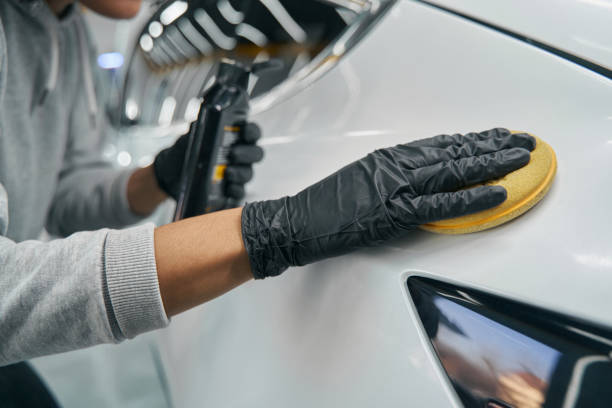
A coat of quality wax forms a sacrificial barrier between your paint and the brutal mix of UV rays, road salt, acid rain, bird droppings, and stray grocery‑cart bumps. Modern clear‑coats are thin; car waxing in Atlanta GA replenishes the missing oils that keep paint flexible, helping it shrug off micro‑scratches instead of absorbing them.
Paste, Liquid, or Spray? Choosing the Right Wax
- Hard paste delivers the longest‑lasting shine—think concurs‑level gloss that survives a full rainy season.
- Liquid wax balances endurance and speed, ideal for weekend warriors who wash and wax in the same afternoon.
- Spray wax is the five‑minute refresh. Use it between full details to top up gloss after a tunnel wash.
Natural Carnauba vs. Synthetic Sealant
Brazilian carnauba (the golden stuff) melts into paint, layering warmth and depth that purists swear by. Synthetic polymer sealants bond chemically, trading a touch of glow for six‑month longevity. Pro tip: layer carnauba over a cured sealant for the best of both worlds.
Prep Work: The Secret Sauce of Showroom Shine
Wax hides nothing. Decontaminate first:
- Snow‑foam pre‑wash lifts grit.
- Two‑bucket hand wash prevents swirl marks.
- Clay‑bar treatment yanks embedded tar and rail dust.
- Light polish erases oxidation. Now the paint is ready to grip wax like Velcro.
Application Techniques That Pros Use
Work in a cool, shaded area. Apply wax in thin, even circles using a microfiber applicator. Let it haze (time varies by product and humidity), then buff with a plush towel, flipping sides often. A dual‑action polisher with a soft finishing pad cuts application time in half on SUVs and vans.
Common Mistakes to Avoid
- Too much product. More wax means more elbow grease, not extra protection.
- Direct sunlight. Heat bakes wax prematurely, leaving stubborn streaks.
- Using household towels. Cotton loops mar clear‑coat; stick to edgeless microfiber.
How Often Should You Wax?
Rule of thumb: every three months for daily drivers, twice a year for garage queens. In coastal climates, shorten the cycle; salt air accelerates corrosion. Perform the bead test—if water no longer forms tight droplets, it’s time to re‑wax.
Waxing for Special Finishes
- Matte paint: Skip traditional wax; use a designated matte sealant to avoid unwanted gloss.
- Ceramic‑coated cars: Light spray waxes labeled “SiO₂‑compatible” revive hydrophobicity without clogging the coating.
- Vintage lacquer: Use pure carnauba—abrasive cleaners can thin delicate single‑stage paint.
Eco‑Friendly & Quick‑Detailing Alternatives
Water‑based hybrid waxes ditch petroleum solvents, curing in fifteen minutes and rinsing clean without shedding harmful runoff. If you’re apartment‑bound, consider rinse‑less wash‑and‑wax concentrates that use a single gallon of water.
Frequently Asked Questions
Q1. Can waxing remove scratches?
No, waxing only fills hairline swirls temporarily. Deeper scratches require compound polishing or touch‑up paint.
Q2. Is machine waxing safe for beginners?
A dual‑action polisher with a finishing pad is virtually fool‑proof; it oscillates instead of spinning aggressively, reducing burn‑through risk.
Q3. What temperature is ideal for waxing outdoors?
Between 15 °C and 25 °C (59 °F–77 °F). Too cold, and wax won’t cure; too hot, and it flashes off.
Q4. Does clear‑coat negate the need for wax?
Clear‑coat is porous and erodes under UV. Wax acts as sunscreen, extending its life.
Q5. Can I wax plastic trim and headlights?
Avoid textured plastic—it turns white. However, waxing polycarbonate headlights adds a UV shield that slows yellowing.
Bottom line
Regular professional car waxing is inexpensive insurance against fading paint and resale‑value loss. With the right prep, technique, and product, your daily driver can boast a mirror finish that turns heads at every stoplight—all in under a thousand words.





